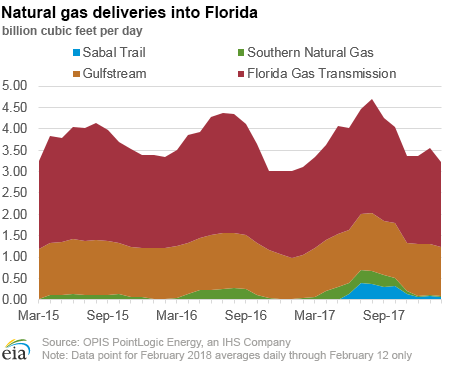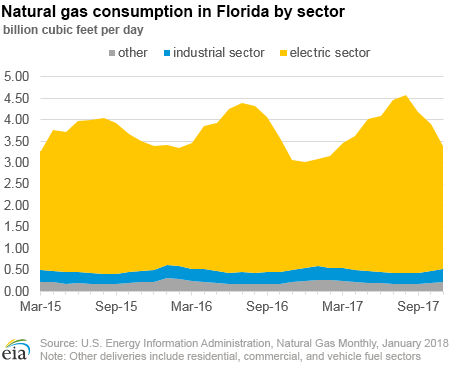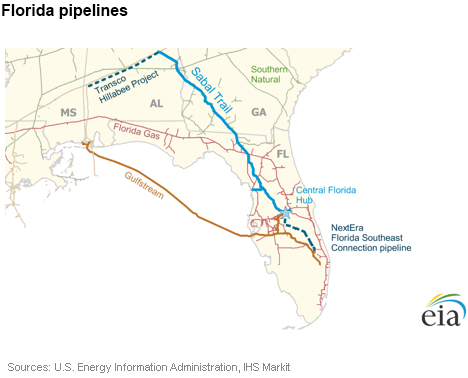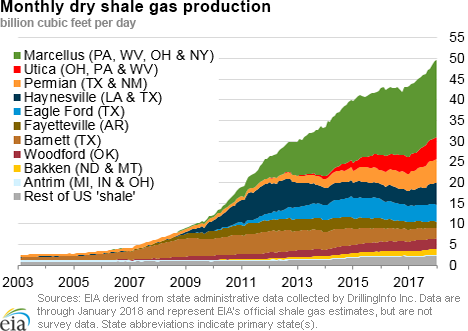In the News:
The Sabal Trail Pipeline continues to face court challenges related to its emissions assessments
The Sabal Trail Pipeline, which transports natural gas from Alabama to Florida, was authorized by the Federal Energy Regulatory Commission (FERC) to begin full service on July 3, 2017. EIA previously reported that this pipeline will help supply natural gas to the growing fleet of natural gas-fired power plants in the state. As of November 2017, EIA data showed 38.4 gigawatts (GW) of natural gas-fired generation capacity in Florida, up 2% from a year ago, with 2 GW of new capacity planned for 2018. Sabal Trail is one part of a three-part project called the Southeast Markets Pipeline (SMP) project, which, when completed, will be capable of delivering more than 1 billion cubic feet per day (Bcf/d) of natural gas into the state.
In August 2017, not long after the Sabal Trail Pipeline entered service, the United States Court of Appeals for the District of Columbia (DC) Circuit Court ruled that FERC did not adequately address greenhouse gas emissions in the SMP project’s Environmental Impact Statement (EIS). The court stated that FERC should have included a “quantitative estimate of the downstream greenhouse gas emissions that will result from burning the natural gas that the pipelines will transport or explained more specifically why it could not have done so.” This ruling would have invalidated the construction approvals for the project, but FERC and pipeline owners requested another hearing, and the approvals were left in place temporarily.
In October 2017, FERC prepared a draft supplemental EIS (SEIS) for the project to address the shortcomings identified by the DC Circuit Court and opened the document to public comment. Last week, FERC issued the "final" SEIS, taking into consideration both the Court’s request for better environmental metrics and reconciling more than 100 comments from the public on the draft SEIS. Issuing the SEIS allowed construction and service on the larger SMP project, which includes Sabal Trail, to continue without interruption.
Though the Sabal Trail pipeline transported natural gas to help meet electricity demand in Florida last summer, data from PointLogic show that in recent months, flows on the pipeline have been relatively low. In January 2018, for example, the pipeline transported an average of 93 million cubic feet per day (MMcf/d) compared to its current capacity of about 810 MMcf/d. For more than half of the days in January, no natural gas was delivered on the line. However, on January 4, which was an extremely cold day throughout the eastern half of the country, the pipeline sent out 814 MMcf to help meet electric demand. (Many Florida residents, as is common in the Southeast, use electricity to heat their homes.)
Florida’s natural gas market is dominated by power sector consumption. In 2017, EIA data showed that approximately 86% of all deliveries in the state went to the electric sector. Industrial consumers used about 8% of deliveries, and the remaining 6% went to residential/commercial and vehicle fuel consumers.
Most of the natural gas delivered into Florida enters via the Florida Gas Transmission line, which crosses from Alabama into the panhandle of Florida. The Gulfstream Pipeline, which delivers natural gas from the Gulf Coast underwater through the Gulf of Mexico and into Tampa, is the second largest source of deliveries into Florida. Together, the two lines accounted for 92% of all volumes delivered into Florida in 2017. Southern Natural Gas has three lines that deliver small quantities of natural gas across the northern border of Florida for most months outside of winter, but accounts for only a small portion of total deliveries into the state.
Overview:
(For the Week Ending Wednesday, February 14, 2018)
- Natural gas spot prices fell at most locations this report week (Wednesday, February 7 to Wednesday, February 14). The Henry Hub spot price fell from $2.73 per million British thermal units (MMBtu) last Wednesday to $2.51/MMBtu yesterday.
- At the New York Mercantile Exchange (Nymex), the March 2018 contract price fell 12¢ from $2.702/MMBtu last Wednesday to $2.587/MMBtu yesterday.
- Net withdrawals from working gas totaled 194 billion cubic feet (Bcf) for the week ending February 9. Working natural gas stocks are 1,884 Bcf, which is 23% less than the year-ago level and 19% lower than the five-year (2013–17) average for this week.
- The natural gas plant liquids composite price at Mont Belvieu, Texas, fell by 8¢, averaging $7.23/MMBtu for the week ending February 14. The price of natural gasoline, butane, and isobutane fell by 6%, 5%, and 3%, respectively. The price of ethane and propane rose by 3% and 1%, respectively.
- According to Baker Hughes, for the week ending Tuesday, February 6, the natural gas rig count increased by 3 to 184. The number of oil-directed rigs rose by 26 to 791. The total rig count increased by 29, and it now stands at 975. This increase was the largest weekly increase in total rigs since January 2017.
Prices/Supply/Demand:
Spot prices fall east of the Rockies. This report week (Wednesday, February 7 to Wednesday, February 14), the Henry Hub spot price fell 22¢ from $2.73/MMBtu last Wednesday to $2.51/MMBtu yesterday, the lowest it has been since March 2017. At the Chicago Citygate, prices decreased 23¢ from $2.67/MMBtu last Wednesday to $2.44/MMBtu yesterday. Prices at PG&E Citygate in Northern California rose 25¢, up from $2.54/MMBtu last Wednesday to $2.79/MMBtu yesterday. The price at SoCal Citygate increased $1.85 from $2.58/MMBtu last Wednesday to $4.43/MMBtu yesterday, with a weekly low of $2.49/MMBtu on Friday. Southern California experienced colder-than-normal temperatures during the latter part of the report period.
Northeast spot prices decrease significantly. Prices in the Northeast fell as temperatures warmed. At the Algonquin Citygate, which serves Boston-area consumers, prices went down $5.68 from $8.10/MMBtu last Wednesday to $2.42/MMBtu yesterday. Some fluctuations in price occurred during the week amid changing Northeast temperatures. At the Transcontinental Pipeline Zone 6 trading point for New York, prices decreased $2.36 from $4.81/MMBtu last Wednesday to $2.45/MMBtu yesterday.
Tennessee Zone 4 Marcellus spot prices decreased 55¢ from $2.40/MMBtu last Wednesday to $1.85/MMBtu yesterday. Prices at Dominion South in northwest Pennsylvania fell 49¢ from $2.47/MMBtu last Wednesday to $1.98/MMBtu yesterday.
Nymex prices fall. At the Nymex, the price of the March 2018 contract decreased 12¢, from $2.702/MMBtu last Wednesday to $2.587/MMBtu yesterday. On Monday, the March contract was $2.552/MMBtu, the lowest front-month contract price since August 2016. The price of the 12-month strip averaging March 2018 through February 2019 futures contracts declined 5¢ to $2.773/MMBtu.
Supply remains flat. According to data from PointLogic Energy, the average total supply of natural gas remained the same as in the previous report week, averaging 83.9 Bcf/d. Dry natural gas production remained constant week over week. Average net imports from Canada decreased by 4% from last week but were a small contributor to the overall supply.
Demand falls. Total U.S. consumption of natural gas fell by 7% compared with the previous report week, according to data from PointLogic Energy. Natural gas consumed for power generation climbed by 2% week over week. Industrial sector consumption decreased by 2% week over week. In the residential and commercial sectors, consumption declined by 14%. Natural gas exports to Mexico decreased 1%.
U.S. liquefied natural gas (LNG) exports decrease week over week. Five LNG vessels (LNG-carrying capacity 17.2 Bcf combined) departed the Sabine Pass liquefaction facility from February 7 to February 14. One tanker (LNG-carrying capacity 3.8 Bcf) was loading at the terminal on Wednesday.
On February 8, the U.S. Department of Transportation’s Pipeline and Hazardous Materials Safety Administration (PHMSA) issued an order to shut down two leaking storage tanks at Cheniere Energy’s Sabine Pass LNG facility in Cameron Parish, Louisiana. Tanks S-101 and S-103 have been removed from service pending further PHMSA investigation. The three remaining storage tanks will continue to operate.
Dominion Energy, the operator of the Dominion Energy Cove Point liquefaction facility in Lusby, Maryland, has stated that the company is not required to post natural gas feedstock deliveries to the terminal while the facility is undergoing commissioning. Bentek Energy estimates that the feed gas flows to the terminal averaged 35 MMcf/d in early December, and around 160 MMcf/d in late January. The terminal began producing LNG on January 31, and commercial deliveries are expected to start in early March.
Storage:
Working gas net withdrawals are 40 Bcf higher than the five-year average. Net withdrawals from storage totaled 194 Bcf for the week ending February 9, compared with the five-year (2013–17) average net withdrawal of 154 Bcf and last year's net withdrawals of 120 Bcf during the same week. Working gas stocks totaled 1,884 Bcf, which is 433 Bcf less than the five-year average and 577 Bcf less than last year at this time. All regions in the Lower 48 states except for the Pacific region are lower than year-ago levels.
Working gas levels are 262 Bcf higher than the five-year minimum. If net withdrawals from working gas stocks match the five-year average for the remainder of the withdrawal season, working gas stocks will total 1,269 Bcf by March 31, 2018, which is 25% lower than the five-year average, and the second lowest end-of-heating-season level reported since 2010. Working gas stocks ended the 2013–14 heating season at 837 Bcf, which is the lowest reported level during that period.
The average March 2018 futures contract price traded at a discount to the average weekly spot price. During the most recent storage week, the average natural gas spot price at the Henry Hub was $2.77/MMBtu, 2¢/MMBtu higher than the front-month futures price at the Nymex. This pricing pattern provided economic incentives to withdraw natural gas from storage to avoid exposure to the spot market. A year ago, the spot price was 9¢ lower than the front-month contract.
Reported withdrawals out of storage are higher than the median of analysts’ expectations for the second week in a row. According to The Desk survey of natural gas analysts, estimates of the weekly net change in working natural gas storage ranged from 174 Bcf to 202 Bcf, with a median of 185 Bcf. Prices for the futures contract for March delivery at the Henry Hub rose about 1¢/MMBtu, averaging $2.59/MMBtu, following the release of the Weekly Natural Gas Storage Report, with 373 contracts traded at the release. Prices remained close to that level in subsequent trading.
Temperatures are lower than normal during the storage week throughout most of the Lower 48 states. Temperatures in the Lower 48 states averaged 34 degrees Fahrenheit (°F), 1°F lower than the normal, 6°F lower than last year at this time, and 6°F lower than the average temperature of last storage week.
See also:
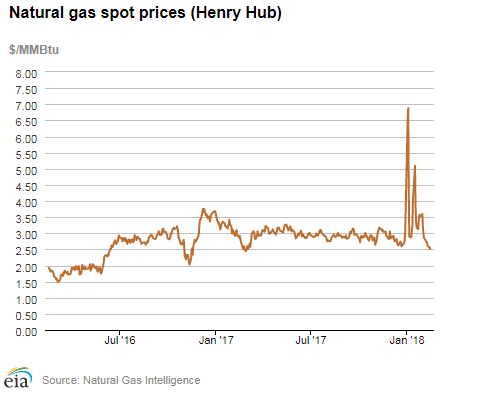
| Spot Prices ($/MMBtu) | Thu, 08-Feb |
Fri, 09-Feb |
Mon, 12-Feb |
Tue, 13-Feb |
Wed, 14-Feb |
|---|---|---|---|---|---|
| Henry Hub |
2.71 |
2.61 |
2.56 |
2.57 |
2.51 |
| New York |
2.87 |
2.68 |
2.77 |
2.59 |
2.45 |
| Chicago |
2.72 |
2.57 |
2.45 |
2.46 |
2.44 |
| Cal. Comp. Avg.* |
2.36 |
2.41 |
2.47 |
2.54 |
2.50 |
| Futures ($/MMBtu) | |||||
| March contract | 2.697 |
2.584 |
2.552 |
2.594 |
2.587 |
| April contract |
2.685 |
2.597 |
2.579 |
2.623 |
2.630 |
| *Avg. of NGI's reported prices for: Malin, PG&E Citygate, and Southern California Border Avg. | |||||
| Source: NGI's Daily Gas Price Index | |||||
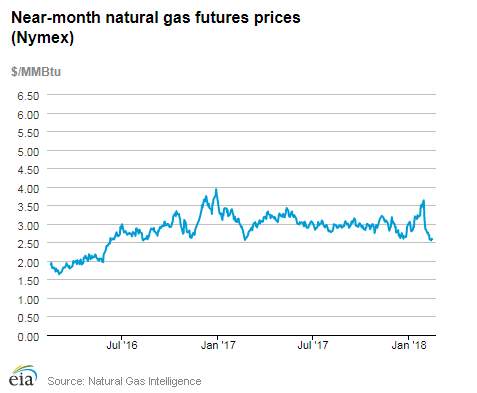
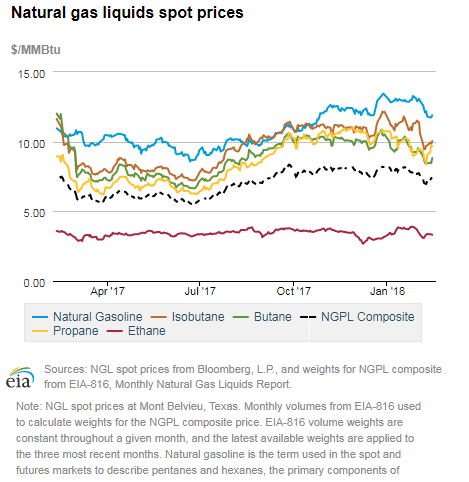
| U.S. natural gas supply - Gas Week: (2/8/18 - 2/14/18) | |||
|---|---|---|---|
Average daily values (Bcf/d): |
|||
this week |
last week |
last year |
|
| Marketed production | 87.6 |
87.5 |
79.2 |
| Dry production | 78.1 |
77.9 |
70.8 |
| Net Canada imports | 5.6 |
5.8 |
6.1 |
| LNG pipeline deliveries | 0.2 |
0.3 |
0.4 |
| Total supply | 83.9 |
84.1 |
77.2 |
|
Source: OPIS PointLogic Energy, an IHS Company | |||
| U.S. natural gas consumption - Gas Week: (2/8/18 - 2/14/18) | |||
|---|---|---|---|
Average daily values (Bcf/d): |
|||
this week |
last week |
last year |
|
| U.S. consumption | 86.4 |
92.6 |
75.4 |
| Power | 23.8 |
23.3 |
20.8 |
| Industrial | 23.2 |
23.7 |
21.7 |
| Residential/commercial | 39.4 |
45.5 |
32.8 |
| Mexico exports | 4.4 |
4.5 |
4.2 |
| Pipeline fuel use/losses | 6.8 |
7.3 |
5.9 |
| LNG pipeline receipts | 3.2 |
3.3 |
2.2 |
| Total demand | 100.8 |
107.7 |
87.7 |
|
Source: OPIS PointLogic Energy, an IHS Company | |||
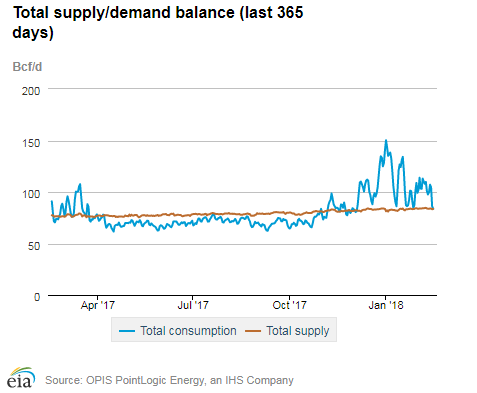
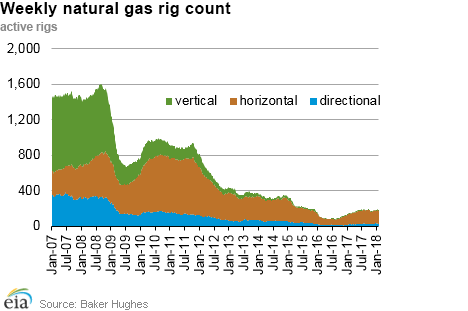
| Rigs | |||
|---|---|---|---|
Fri, February 09, 2018 |
Change from |
||
last week |
last year |
||
| Oil rigs | 791 |
3.4% |
33.8% |
| Natural gas rigs | 184 |
1.7% |
23.5% |
| Note: Excludes any miscellaneous rigs | |||
| Rig numbers by type | |||
|---|---|---|---|
Fri, February 09, 2018 |
Change from |
||
last week |
last year |
||
| Vertical | 70 |
6.1% |
2.9% |
| Horizontal | 832 |
3.0% |
37.1% |
| Directional | 73 |
1.4% |
10.6% |
| Source: Baker Hughes Inc. | |||
| Working gas in underground storage | ||||
|---|---|---|---|---|
Stocks billion cubic feet (Bcf) |
||||
| Region | 2018-02-09 |
2018-02-02 |
change |
|
| East | 432 |
488 |
-56 |
|
| Midwest | 468 |
543 |
-75 |
|
| Mountain | 122 |
131 |
-9 |
|
| Pacific | 213 |
213 |
0 |
|
| South Central | 649 |
703 |
-54 |
|
| Total | 1,884 |
2,078 |
-194 |
|
| Source: U.S. Energy Information Administration | ||||
| Working gas in underground storage | |||||
|---|---|---|---|---|---|
Historical comparisons |
|||||
Year ago (2/9/17) |
5-year average (2013-2017) |
||||
| Region | Stocks (Bcf) |
% change |
Stocks (Bcf) |
% change |
|
| East | 485 |
-10.9 |
500 |
-13.6 |
|
| Midwest | 648 |
-27.8 |
581 |
-19.4 |
|
| Mountain | 151 |
-19.2 |
142 |
-14.1 |
|
| Pacific | 205 |
3.9 |
233 |
-8.6 |
|
| South Central | 972 |
-33.2 |
861 |
-24.6 |
|
| Total | 2,461 |
-23.4 |
2,317 |
-18.7 |
|
| Source: U.S. Energy Information Administration | |||||
| Temperature – heating & cooling degree days (week ending Feb 08) | ||||||||
|---|---|---|---|---|---|---|---|---|
HDD deviation from: |
CDD deviation from: |
|||||||
| Region | HDD Current |
normal |
last year |
CDD Current |
normal |
last year |
||
| New England | 261 |
-10 |
22 |
0 |
0 |
0 |
||
| Middle Atlantic | 271 |
12 |
55 |
0 |
0 |
0 |
||
| E N Central | 335 |
51 |
84 |
0 |
0 |
0 |
||
| W N Central | 358 |
65 |
84 |
0 |
0 |
0 |
||
| South Atlantic | 175 |
2 |
52 |
10 |
3 |
0 |
||
| E S Central | 188 |
14 |
61 |
0 |
0 |
-1 |
||
| W S Central | 127 |
4 |
60 |
0 |
-4 |
-15 |
||
| Mountain | 155 |
-60 |
-17 |
1 |
0 |
1 |
||
| Pacific | 35 |
-74 |
-65 |
0 |
0 |
0 |
||
| United States | 216 |
3 |
37 |
2 |
1 |
-2 |
||
|
Note: HDD = heating degree day; CDD = cooling degree day Source: National Oceanic and Atmospheric Administration | ||||||||
Average temperature (°F)
7-Day Mean ending Feb 08, 2018
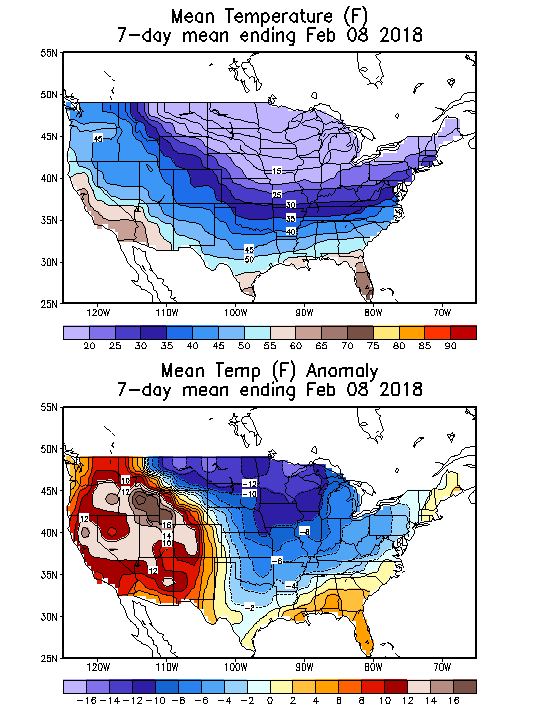
Source: NOAA National Weather Service
Deviation between average and normal (°F)
7-Day Mean ending Feb 08, 2018

Source: NOAA National Weather Service

